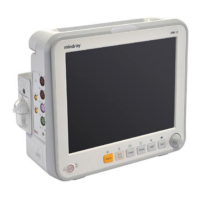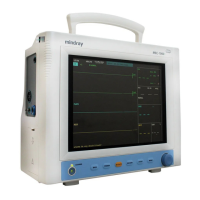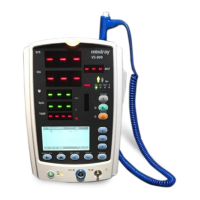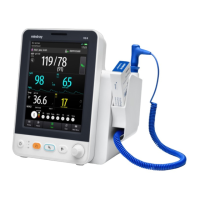D-4
Measurement Alarm message L I Cause and solution
ECG Artifact L C Artifacts are detected on the ECG analysis lead
and as a result heart rate cannot be calculated and
Asystole, Vfib and Vtac cannot be analyzed.
Check the connections of the electrodes and
leadwires and check for any possible source of
interference around the cable and electrode.
Check the patient’s condition and check the
patient for great motion.
ECG High Freq.
Noise
L C High frequency signals are detected on the ECG
analysis lead. Check for any possible source of
interference around the cable and electrode.
ECG Low Freq.
Noise
L C Low frequency signals are detected on the ECG
analysis lead. Check for any possible source of
interference around the cable and electrode.
ECG Amplitude Too
Small
L C The ECG amplitude didn’t reach the detected
threshold. Check for any possible source of
interference around the cable and electrode.
ECG Config. Err L C ECG configuration is wrongly downloaded.
Check the downloaded configuration and
re-download the correct configuration.
Resp Resp Disturbed L C The respiration circuit is disturbed. Restart the
monitor.
Temp Cal. Err L C A calibration failed. Restart the monitor.
T1 Sensor Off L A
Temp
T2 Sensor Off L A
The Temp sensor has become detached from the
patient or the module. Check the sensor
connections.
SpO2 Sensor Off M
*
B
SpO2 Sensor Fault L C
SpO2 No Sensor L B
SpO2 Unknown
Sensor
LC
SpO2 Sensor
Incompatible
LC
The SpO
2
sensor has become detached from the
patient or the monitor, or there is a fault with the
SpO
2
sensor, or an unspecified SpO
2
sensor has
been used. Check the sensor application site and
the sensor type, and make sure if the sensor is
damaged. Reconnect the sensor or use a new
sensor.
SpO2 Too Much
Light
L C There is too much light on the SpO
2
sensor. Move
the sensor to a place with lower level of ambient
light or cover the sensor to minimize the ambient
light.
SpO
2
SpO2 Low Signal L C The SpO2 signal is too low or too weak. Check

